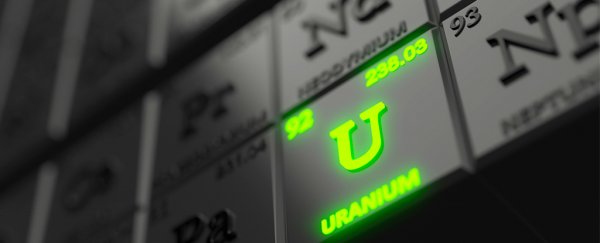Uranium is the radioactive element behind roughly 10 percent of the world's electricity. It's also a heavy metal you certainly don't want lingering inside your body for too long.
However, if you've been exposed to uranium, there are a handful of ways to mop some of it up from your tissues, but most of these methods have inefficiencies or are toxic themselves. Now researchers have designed a molecular 'claw' that could get a better grip on uranium atoms inside animal tissue.
The metal-hugging molecule, developed by chemists from Soochow University in China, seems to get a good grip on uranium atoms, and has already been showing promise in tests with mice.
Most of us don't tend to give uranium poisoning too much thought. Unless you work with the substance or drink from a contaminated well, you're unlikely to come across it in large amounts.
Of the 22 recognised isotopes, only a handful are thought to be toxicologically significant. Just three of those – uranium 234, 235, and 238 – occur naturally.
There have never been any deaths attributed to uranium poisoning, which would probably require swallowing several grams of the element. Even if you were unlucky enough to somehow receive a small dose, your body would ditch two thirds of it fairly quickly.
While the risks are small, the consequences can still be dire. Any remaining material could technically pose a risk, building up in areas like the kidneys and in the bones.
Workers in uranium mines and mills, for instance, face risks of respiratory and kidney disease. Drinking contaminated groundwater also puts consumers at risk of kidney disease.
In 2009, word of widespread uranium poisoning made the news with reports of high levels of the element being found in hair samples taken from children in the Indian state of Punjab. A spike in birth defects and various abnormalities and cancers among children had attracted the suspicions of healthcare workers.
It's not entirely clear where that uranium came from, whether it was contaminants from nearby coal burning power stations or a more natural source. But the fact we don't have an efficient way to treat uranium poisoning should be seen as a serious concern in light of such catastrophes.
Removing heavy metals such as mercury or lead usually requires a form of therapy called chelation, where sticky molecules grab hold of the plus-sized metal atoms and make it easier for your kidneys to dump.
Two chelating agents approved for removal of actinides like uranium are based on the chemical diethylenetriamine pentaacetate (DTPA), a water-loving compound that does a poor job of poking its toe into the fatty membranes of our cells.
So while they can technically be used for uranium, even the US Food and Drug Administration doesn't regard these chelating agents as effective.
There are other candidates that would do a good job of catching uranium, in theory at least, but they tend to come at the expense of causing their own trauma to the kidneys.
One that recently showed promise without being toxic itself is a member of the chelating family known as a hydroxypyridinone.
Of all their candidate chelators, one called 5LIO-1-Cm-3,2-HOPO stood out for its potential to grip onto stray uranium isotopes based on various laboratory studies.
It also proved to be less toxic than the other choices when evaluated on rat tissue; not exactly a gold-star rating, but a definite improvement on current options.
Tested on uranium-dosed mice, the chelating agent managed to remove roughly 80 percent of the residual uranium in their kidneys, and about a half to a third of it from their bones when given an injection straight into their abdomens.
To put it in perspective, other options based on DTPA barely managed to remove about one fifth of the uranium built up in their kidneys and one tenth from their bones.
It's clear there's no silver bullet for clearing the system of all uranium from a potentially toxic dose, but if clinical trials were to go well, it could make a difference for those who are unfortunate enough to be at risk of uranium poisoning.
Punjab's contaminated water isn't the only example in India, making uranium poisoning a significant health crisis wherever people turn to wells for fresh drinking water.
Cleaning up water sources would go a long way to avoid these kinds of problems. But having an efficient way to pull uranium out of our bodies sure wouldn't go astray in those worst-case scenarios.
This research was published in Nature.
